| dc.description.abstract | Dryland ecosystems support over 2 billion people and are major providers of critical ecosystems goods and services globally. However, desertification continues to pose a serious threat to the sustainability of the drylands and livelihoods of communities inhabiting them. The desertification problem is well exemplified in the arid and semi-arid lands (ASALs) in Kenya which cover approximately 80% of the total land area. This study aimed to 1) determine what agropastoralists attribute to be the causes of desertification in a semi-arid land in Kenya, 2) document sustainable land management (SLM) technologies being undertaken to improve livelihoods and combat desertification, and 3) identify the factors that influence the choice of the sustainable land management (SLM) technologies. Results show that agropastoralists inhabiting the semi-arid lands in southeastern Kenya mainly attribute desertification to the recurrent droughts and low amounts of rainfall. Despite the challenges posed by desertification and climate variability, agropastoralists in the study area are using a combination of SLM technologies notably dryland agroforestry using drought tolerant species (indigenous and exotic), grass reseeding using perennial native and drought tolerant grass species (vegetation reestablishment) and in-situ rainwater harvesting to improve livelihoods and by extension combat desertification. Interestingly, the choice and adoption of these SLM technologies is influenced more by the additional benefits the agropastoralists can derive from them. Therefore,it isrationale toconclude that success in dryland restorationand combating desertification lies in programs and technologies that offer a “win-win” scenario to the communities inhabiting the drylands. | en_US |

